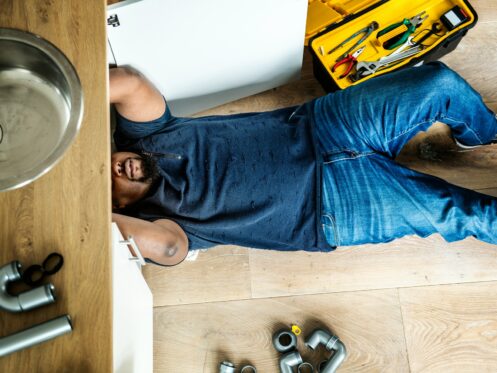Plumbing problems can cause headaches for homeowners. In West Palm Beach, common issues such as leaky faucets, clogged drains, running toilets, and low water pressure can disrupt your daily routine. While some problems may seem minor, they can lead to significant damage if not addressed promptly.
Recognizing the signs of common plumbing issues early can save you time, money, and frustration. From understanding why a faucet drips to knowing how to fix a slow drain, a little knowledge can go a long way. In this article, we’ll guide you through spotting and resolving these plumbing problems so you can maintain a smoothly running home.
Leaky Faucets and Pipes
Hearing the constant drip of a leaky faucet can drive anyone crazy, but that’s not the only sign of a problem. You might also notice water stains on walls or floors, damp cabinets under sinks, or even a sudden increase in your water bill. Leaks can lead to mold, water damage, and wasted water.
Potential causes for leaky faucets and pipes include worn-out washers, loose parts, corrosion, or faulty seals. In some cases, high water pressure can even cause leaks, particularly in older plumbing systems.
Diagnosing a leak can start with a visual inspection. Check all faucets, showerheads, and exposed pipes for visible water or moisture. Tighten any loose connections and replace washers or seals if necessary. For hidden leaks, you may need to listen for dripping sounds within walls or use a moisture detector.
Preventing future leaks involves regular maintenance. Check your plumbing fixtures often and replace aging parts as needed. Using plumbers tape can help seal connections, and reducing your water pressure can ease stress on your pipes. Keeping an eye out for signs of leakage can save you from bigger problems down the road.
Slow or Clogged Drains
When your sink or shower drains slowly, it’s a clear indicator that something is blocking the water flow. You might notice water pooling around your feet in the shower or dirty water backing up in the sink. Standing water and foul odors often accompany these problems.
Common household items that cause clogs include hair, soap scum, food particles, grease, and even small objects accidentally washed down the drain. Over time, these items accumulate and restrict the flow of water.
DIY solutions for clogged drains are often quite effective. First, try using a plunger to dislodge the clog. If that doesn’t work, a mixture of baking soda and vinegar followed by hot water can help break down the buildup. For more stubborn clogs, a drain snake or an auger can be used to reach deeper into the pipes.
Preventative maintenance is key to keeping your drains clear. Use drain covers to catch hair and food particles before they go down the drain. Avoid pouring grease or oil into sinks, and regularly flush your drains with a mixture of baking soda, vinegar, and hot water. If DIY methods don’t solve the problem, it’s time to call a professional to inspect and clean your plumbing system.
Running Toilets
A running toilet is more than just an annoyance; it can waste a significant amount of water. To identify a running toilet, listen for the sound of water trickling long after you’ve flushed. Look inside the toilet tank to see if water is constantly flowing into the bowl, which is a sure sign of a running toilet.
Common causes of a running toilet usually revolve around the flapper, flush valve, or fill valve. The flapper may be worn out or not sealing properly. The chain connected to the flapper may be tangled, or the fill valve might be set too high, causing water to overflow into the toilet bowl.
To fix a running toilet, begin by inspecting the flapper for any visible damage. Replace the flapper if it appears worn out. Adjust the chain to ensure it is not too tight or too loose. Finally, check the fill valve’s height and make necessary adjustments to keep the water level below the overflow tube.
Running toilets waste a lot of water and increase your water bill. Fixing these issues promptly will not only save water but also improve the efficiency of your home’s plumbing system.
Low Water Pressure
Low water pressure can make simple tasks like showering or washing dishes take much longer. You can notice low water pressure if the water trickles out slowly rather than flowing forcefully from faucets and showerheads.
Several potential sources within the home can cause low water pressure. Common culprits include clogged aerators, faulty pressure regulators, and leaks in the plumbing system. Sometimes, the issue might be with the municipal water supply.
For easy fixes, start by cleaning out the aerators on your faucets and showerheads; mineral deposits can block water flow. Adjusting the pressure regulator can also restore normal pressure if it’s set too low. Ensure that all shutoff valves are fully open.
When you’ve tried these fixes without success, it’s time to call for professional help. Issues like leaks within walls or underground are best left to experienced plumbers who can handle complex repairs safely and effectively.
Conclusion
Addressing common plumbing issues like leaky faucets, clogged drains, running toilets, and low water pressure can keep your home running smoothly and save you from costly repairs. Regular checks and maintenance can prevent minor problems from turning into major headaches.
It’s essential to know when to handle a plumbing issue yourself and when to call in the professionals. While some problems have simple solutions, others require the expertise of a qualified plumber to ensure they are fixed correctly and safely.
If you encounter any plumbing problems that are too difficult to manage on your own, or if you need regular maintenance, don’t hesitate to contact Legacy Plumbing Experts. Our team is here to help you keep your home’s plumbing system in top shape. Don’t wait until a minor issue becomes a major problem; contact Legacy Plumbing Experts today for plumbing services!

